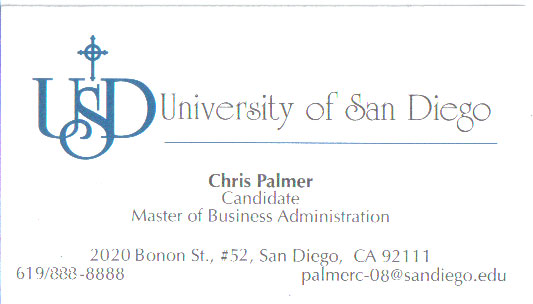A weblog by one of AOL’s senior technical directors. Some very interesting thoughts on management in a technology context.
A new stepping stone in my quest to become a huge dork: I have business cards. For my MBA program. Ha!

Yeah, so I changed a few details, but you get the idea.
PS – Weather update: still no rain and only two cloudy days. A native San Diegoan exclaimed, “it feels like fall!” That was days ago, and today I did note that it was slightly colder. I might wear pants instead of shorts to school tomorrow. Maybe.
I am at the beginning of a 16 month full time MBA program here at USD. It’s the first year USD has a full time cohort (they’ve been doing part time and international for a while), and they’re doing it presumably in order to get on the rankings.
Another way to get attention would be this: get the Dean arrested. That’s right; our Dean was apparently caught in Cleveland of all places, for “complicity to possess drugs.” Now, buying drugs registers a big zero on my moral outrage scale, but come on. Cleveland? Do you seriously want anything in your body that comes from Cleveland?
UPDATE! For some reason “Breakfast with the Dean” has been renamed to just a breakfast for alumni on the MBA website. They move fast.
It seems that now is the season of business books, and I just recently finished “businessThink”. This was pretty much introducing and exploring a different method of finding solutions for business. Some good stuff here.
Steps are:
- Check Ego at the door
- Create curiosity
- Move off the solution
- Gather evidence (soft and hard)
- Measure Impact ($ of solving and not solving. Is this a could or a should?)
- Explore the ripples (other departments effected)
- Watch out for Yellow lights (why hasn’t this been done already?)
- Find the Cause (ask Why)
5 questions to convert hard evidence into impact:
- How do you measure it?
- What is it now?
- What would you like it to be?
- What’s the value of the difference?
- What’s the value of the difference over time (months, years, the
appropriate management horizon)?
“The Holy Grid” (graph out how a decision is going to be made (committees,
etc))
| Steps | Decision | When | Who | How |
I just read “Winning” by Jack Welch and it’s a surprisingly good management book. It boils down to common sense, positive attitude and hard work which was refreshing. Some notes:
Positive attidute, boundless curiosity (keep asking questions, preferably ones that prompt action), candor and breath your company’s mission statement (which means it should be a good one).
Hiring
Acid Test: Integrity, intelligence, maturity
4-e (1-p): Positive Energy, ability to Energize others, Edge (tough yes or no decisions), ability to Execute (get the job done) and Passion (both job and outside hobbies/activities).
Hiring for the Top: Authenticity, ability to see around corners, “strong penchant to surround themselves with people better and smarter than they are,” and heavy duty resilience.
3 firing mistakes:
Moving too fast (confusion and out of the blue firing), not using enough candor and taking too long (dead man walking).
Crisis:
- Problem is worse than it appears.
- No secrets. It all gets out eventually.
- Your handling of the situation will be portrayed in the worst light.
- There will be changes in process and people (“blood on the floor”).
- The organization will survive, and probably be stronger for the experience.
He also talked about his 20/70/10 rule which basically means richly reward, train and groom your superstars, spend a lot of attention on the middle 70% (majority of your workforce) and nuke the underperforming 10%. Good or bad hiring decisions should be known in a year.
